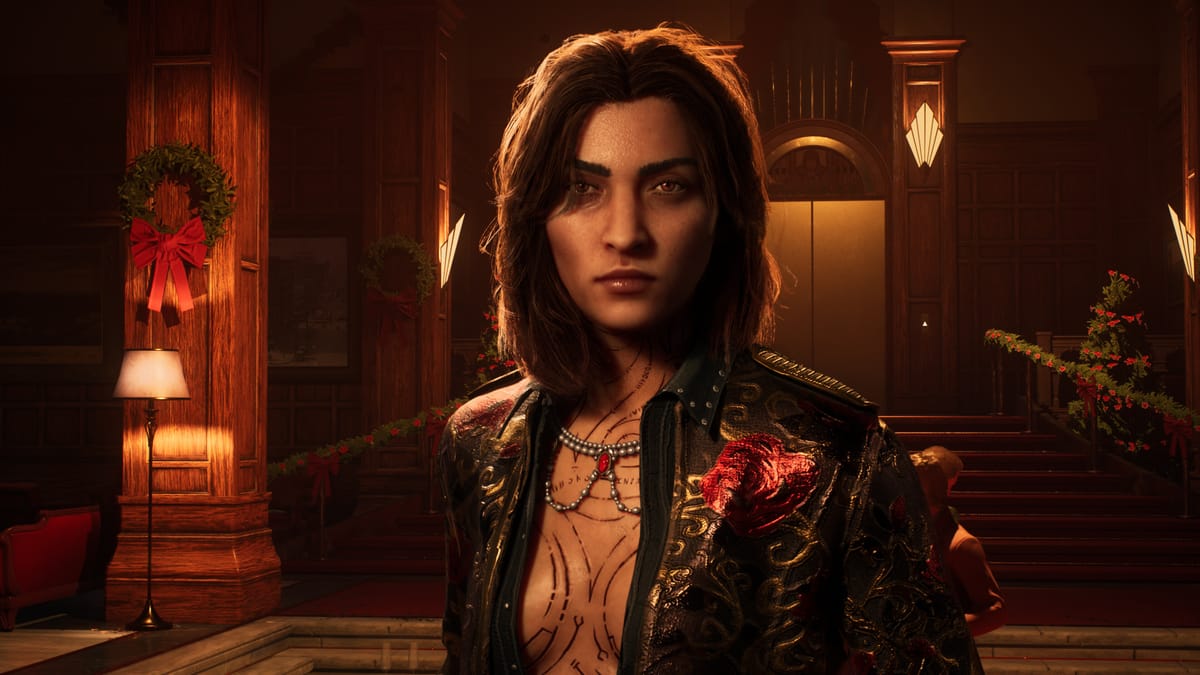
The steam rises from the dark underbelly of Seattle’s streets, where neon lights flicker like the last breaths of a dying world. In these streets lies a hidden society, deeply rooted in tradition, politics, and an ever-shifting cost to power. Few games carry the weight of expectation like Vampire: The Masquerade – Bloodlines 2 and, as the long-awaited successor to the cult classic original, this could spell the resurrection of a series, or potentially drive a stake into its heart for another two decades. That’s a lot of weight for any game studio, much less one that stepped in to rescue a project after years of delays and developmental struggle. Can this sequel resurrect the deception, intrigue, and incredible writing of the original in a modern landscape, or will it sink back into the darkness from whence it came? Sink your teeth in, we’ve got a lot to talk about.
As is always the case, we will try to steer clear of spoilers to the extent possible. I’ll touch on certain elements, but when there is more than a passing amount of information, I’ll clearly delineate it. I want you to enjoy the storyline, so I’ll do my best to avoid anything that would ruin that for you.
Before we get rolling on Bloodlines 2, I want to take a moment and wipe away the nostalgia from those rose-tinted glasses, thinblood. I was there in 2004, I reviewed Vampire: The Masquerade - Bloodlines, and I loved it. I loved it despite itself. It was the first game to use the Source 2 engine outside of Valve, and the team at Troika did their best. Unfortunately, for a long while after launch, and to some degree after that studio’s closure, the game was an absolute mess.
The Source engine gave the original game advanced facial animations that were well beyond their time, but tense story moments being interrupted by Jeanette’s eyeballs spinning like a slot machine in her skull derailed the experience. Missing heads, textures that don't load, awful pop-in and audio problems, muzzle flash that didn’t stop flashing, busted quest triggers and missing items, framerate issues, and far more plagued the original, and that's only if you could get it to load – black loading screens and crashes to desktop were common. Add to that a fairly lackluster combat system, a hacked together story with missing elements cut for time, and a beta engine to run it on (Half-Life 2 launched on the 1.0 version, this game launched with the Beta version of the engine) and you have a game that should not gather the praise it does. What it did have was writing, mood and setting, incredible voice acting, and characters that were memorable. Enough to carry the game forward where devoted fans have lovingly restored every bit of available content, patched most of the bugs, and continue to work on it to this day. What it wasn’t was a particularly good RPG or an overly complex first person combat experience. What you’re remembering in your head is far more positive than what shipped in the box. I say all this because that was the foundation that publisher Paradox Interactive and developers Hard Suit Labs and, ultimately, The Chinese Room had to build on. They had to dig their way out of a hole before they could even start.

Speaking of starts, yours is a rather rough one in Bloodlines 2. Once you pick your sex and some basic looks, you’ll find yourself staring at what appears to be an abandoned building with a flashlight right in your eyes thanks to a random security guard. You are immediately scrambling for blood as you exit torpor – the undeath that is vampiric sleep. Confused, and about 100 years out of your lane, you now scramble to come to grips with a modern world, a changed political hierarchy, and a persistent and nagging problem – another voice inside your head.
Bloodlines 2 tells the story from two perspectives, that of the Nomad (also known as Phyre) – an elder vampire awakening from slumber, albeit stripped of their power and position, and a vampire detective named Fabien who has somehow ended up attached as an entity in your mind. How he ended up there, how he met the True Death, who attached him to Phyre, who put them into torpor, and who had the audacity to brand them are all mysteries left to unravel, and all while preserving the inviolate rules that make up The Masquerade. While your legend precedes you, your power and position have long since faded – time to claw your way back to the top.
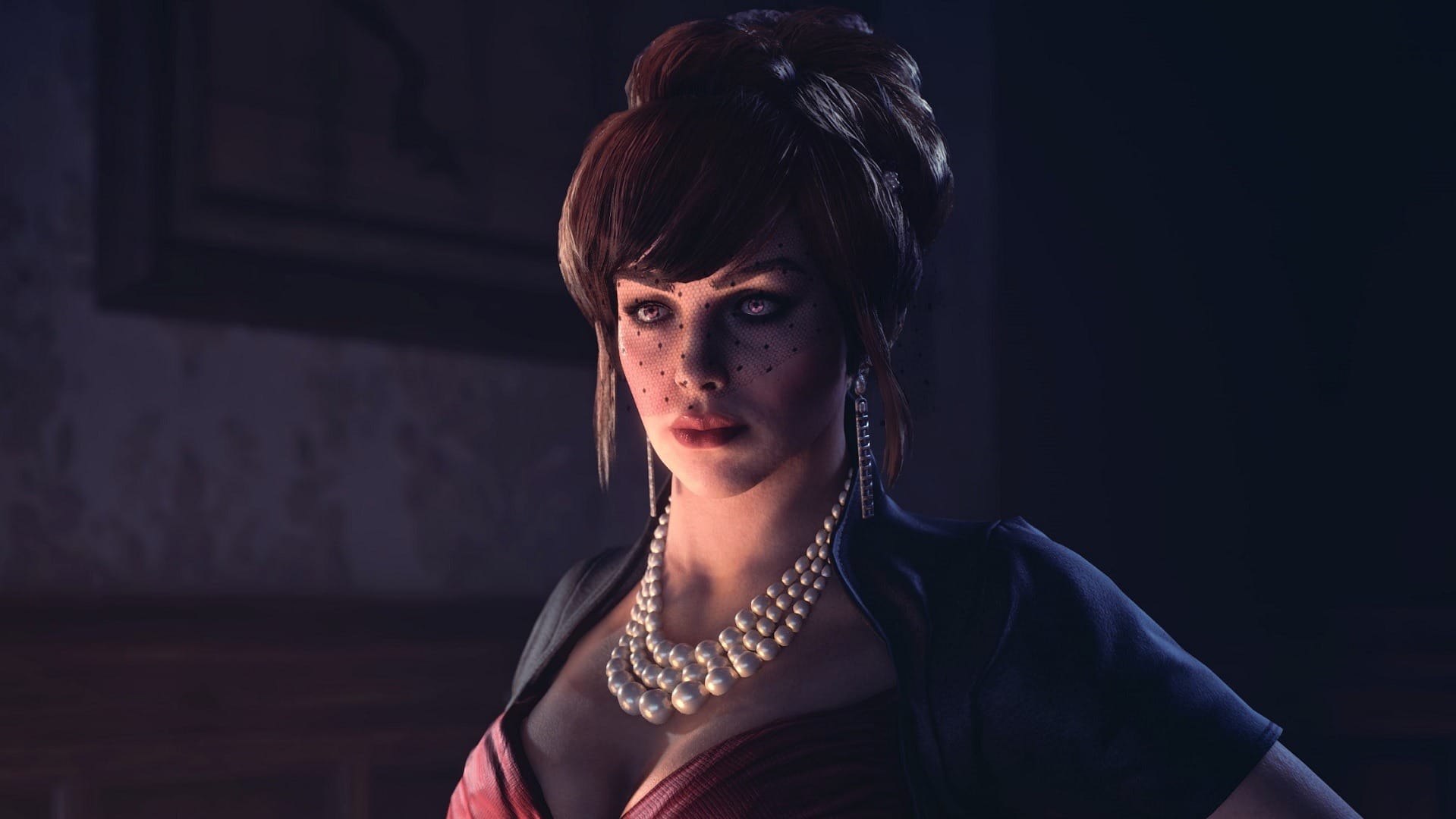
Fabien, your detective hitchhiker, is a bit of help navigating 21st-century Seattle as he knows the local players. A more pressing problem is that you don't have the right to stay in Seattle for long without the express permission of the Prince of the city. You’ll need that to even begin to unravel anything around your circumstances. As you step foot into a world where things like firearms, vehicles, cameras and the Internet exist, you’ll now have to take additional care not to violate The Masquerade. The Masquerade is the guiding rules that expressly forbid any Kindred from exposing their world to mortals. That means don’t move unnaturally fast, don’t feed openly, keep your fangs sheathed, don’t unleash unnatural powers in public, etc. – essentially, blend in at all costs. At its core, The Masquerade is a heavily-enforced disinformation campaign executed by The Camarilla (more on them in a moment) to keep Kindred hidden. Violating The Masquerade is a huge deal, with breaches leading to true-death consequences like imprisonment, a stake to the chest, exposure to the sun, or any other manner of methods to dispatch the offender. The humans involved get bribed, have their minds wiped with Dominate, disappeared, or just gunned down in “gang violence” by Ventrue enforcers. The Masquerade keeps the hidden world hidden.
The Camarilla is the decentralized governing body of Kindred society. They don’t often hold formal positions like Princes or Barrons, but they do make up a body of representatives from all clans, enforcing the six major Traditions – The Masquerade, The Domain, The Progeny, The Accounting, The Hospitality, and The Destruction. Without digging into a rulebook worth of info, this is keeping society safe, not growing it too quickly or without authorization, dealing with transgressions, how to treat other Kindred, and the ultimate punishment when things get out of control. Ignoring these rules, or the body that prescribes them, is done at your own peril. I say all of this because the world and the Camarilla that Phyre knew when they went into the box is very different than the one they awoke to in modern society. Where the rules were rooted in Dark Age society before, it now has more granular recognition of the changes of society, leniency for certain things like siring progeny, and a formalizing of multiple clan offshoots. Not everyone is happy with these changes, leading to a tightening of membership rules, thus expelling the Anarchs, Catiff, and thin-blood (cast-off, inbred, weaker, or clanless vampires) Kindred. You’ll face some of these foes in Bloodlines 2, so it’s good to know why they’re so pissed off at you and the locked world that you represent.
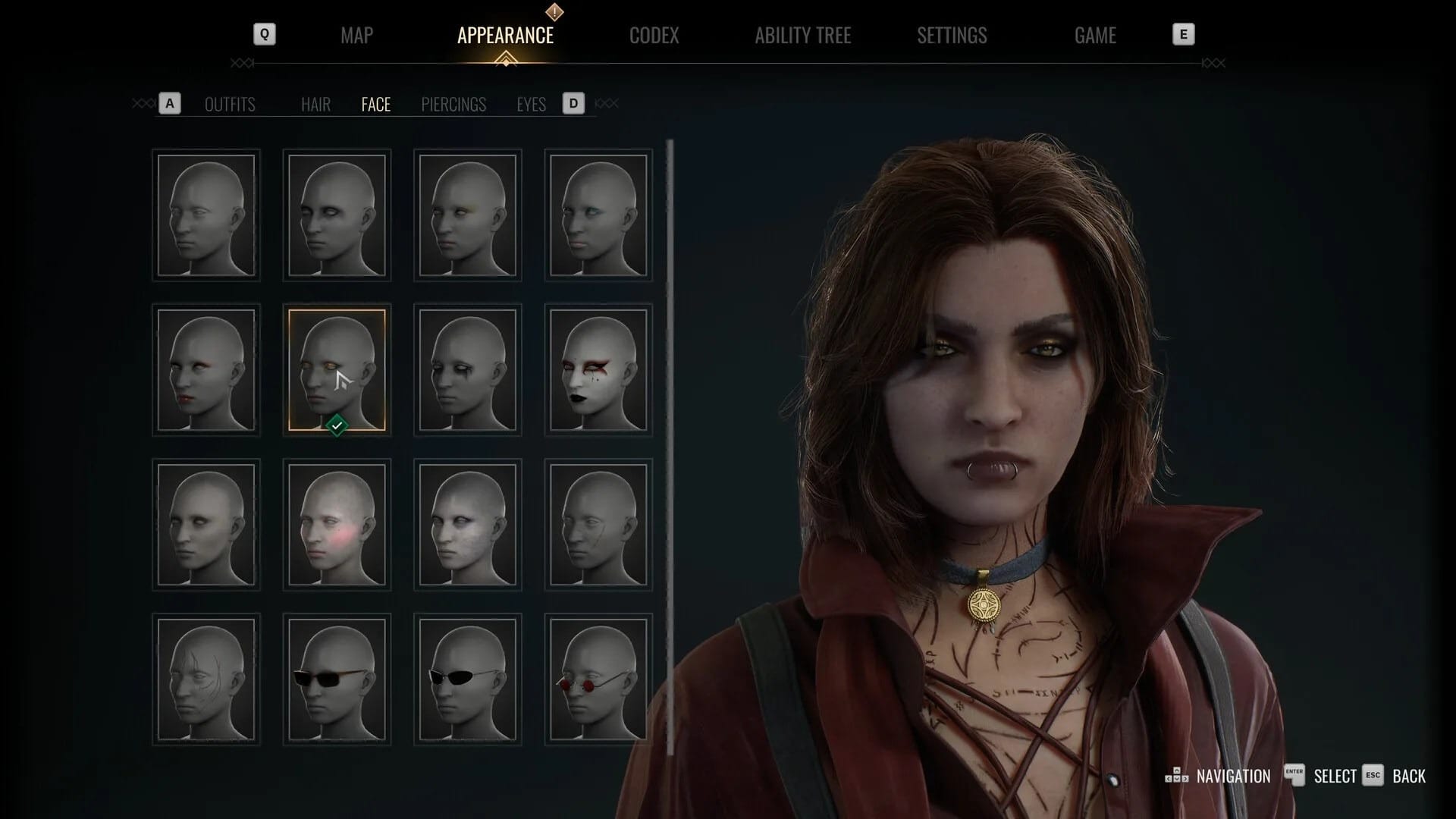
Newly awoken, your powers have somehow been stripped away, a mysterious brand on your hand being somehow linked to this downturn of events. Regaining your powers, once you have permission to even stay in the city, comes from both draining specific types of blood, and specialized training. Shortly into the storyline you’ll begin to see humans marked as having a “Blood Resonance Event in Progress”. Speaking to them will attempt to lure them away in some way (surprisingly, you have absolutely no control over what’s said – they may think you’re hitting on them, robbing them, threatening them, etc. but you have no mechanics to choose). When you do get them away from prying eyes, draining them of blood will reward 100 Sanguine (lust), Choleric (anger), or Melancholic (sadness) points – currency needed to learn new skills, once you find the appropriate trainer to do so. These points, combined with the levels you’ll earn with XP earned in combat and exploration, will give you the necessary items to grow your powers.
Each power is tied to a specific trainer, once you’re granted access by the Prince. For example the Banu Haqim (Based in large part in a hidden fortress Alamut in the Middle East) are great scholars, warriors, guardians, and occasionally great sorcerers. They can teach you powers like Silence of Death (all actions become silent after feeding), Mute (silence an enemy’s actions such as screams or gunfire), Bladed Hand (attack swiftly in front of you, knife handing the heads of foes clean off their shoulders), and more. On the other hand, Tremere are the graceful and charming vampires, with powers such as Entracing Kiss (embrace a foe, turning them into an ally for some time), Blink (instantly dash to a targeted location), and Beckon (put an individual into a docile state where they’ll simply walk towards you blindly), just to name a few. Each of the six clans (Brujah, Tremere, Banu Haqim, Venture, Toreador, and Lasombra) has a number of powers to impart, as well as some bonuses for those who dive deeply into that clan’s specializations. While I’ll miss scurrying around in the sewers as a Nosferatu, there is enough here to keep me busy. The first few are easy enough to find, but I’ll leave the rest to you to uncover.
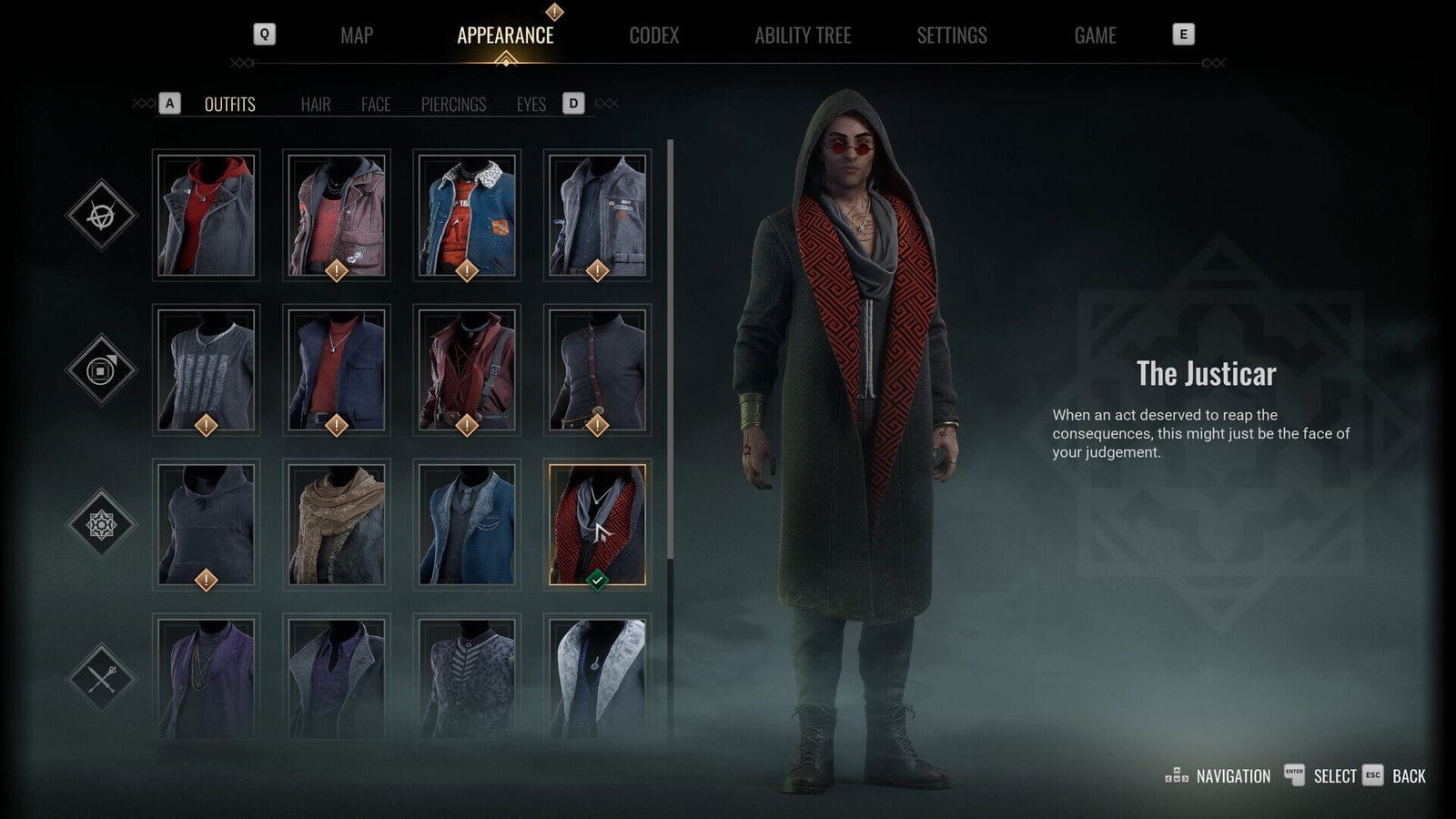
It’s important to note that your discipline track is linear – you’ll unlock tiers with wings off the central spine. You can pick up the aforementioned clan specializations in a method that skews closer to the tabletop version than the original videogame. In that tabletop experience you can pick up skills outside of your clan’s central thread, but they might “cost extra” the more they stray from your clan’s central thread, and all of them require training – something similar to what you see here, enabling you to roleplay as you see fit, albeit at a cost.
For my first playthrough I chose female Tremere – the blood mages of Kindred kind. Basic powers allow you to control your blood, or that of your foes. One example would be Blood Curse, a power that causes the blood of the enemy struck to swell up and explode, doing area of effect damage to all those around them, drenching the area in buckets of viscera. It’s hardly subtle, but it does mean you can face off against groups of enemies, making up for your lack of frontline combat prowess. Dotted throughout this review you’ll find links to all of the clan showcase videos, so feel free to study up before you choose.
Admittedly, I chose a clan marked as “Hard” for difficulty (there are four difficulty levels on top of the challenge the clan presents) for my first run, and I struggled with combat, dying more than a bit in one-on-one fights until I earned a few of my core capabilities to manipulate my foes. In my second run I played as Banu Haqim and it was a completely different experience. Right out of the gate I had the power to simply knife hand a ghoul’s neck, separating their head from their shoulders in a single strike. While much of the beginning choices were the same, some choices diverge with my clan choices, including my dealings with the Pregenitors of the city. It’s not as deep as a game like Baldur’s Gate III, skewing more towards action titles like the Mass Effect series, complete with four choice options for each layer of a conversation. There are very few fail states for conversations, though Fabien’s Malkavian powers offer a few dialogue manipulations I won’t spoil here.
When you are playing as Fabien, the game shifts to essentially a pure detective novel. The world is sepia toned, of course, complete with a jazzy relaxed look and feel. When Fabien moves he does so with a dilation of perception, making his memories move faster instead of actually moving his feet quicker. While he doesn’t engage in combat, the detective work varies things up a bit which is always a nice coda to end the evening’s activities.
Regardless of which clan you align with, there are some skills and powers that are common to all. You have the ability to dodge with the left bumper, zipping out of danger, or rushing your target, which can be combined with an attack for a leaping knee, for example. You can extend this rapid movement to scramble up buildings, skittering up things like vertical pipes and vents, or gripping onto extended air conditioners. You can take an additional leap from that final point, trying to gain purchase with your fingertips to reach another climb point or the rooftops proper. Crouching lets you attempt to blend in for stealth, allowing you to lose line of sight for a pursuing foe. Leaping off of a high building and holding A will allow you to glide, letting you stay on the rooftops away from prying mortal eyes. Holding the right trigger employs telekinesis, grabbing onto bottles, baseball bats, propane tanks, and more. You can fling these to distract a foe to remain in stealth as you slink a different direction, whip it directly into the dome of an enemy to stun them briefly to interrupt a charge, for example. Your foes can use guns, but you don’t have any compunction to use them directly. Instead, you’ll grab the firearm and hold them suspended mid-air, firing them with your telekinesis, flinging them empty at your foes as a bludgeon.
I was happy to see that many of the combat powers available to you are usable in boss battles. Even the incredibly lethal Blood Curse causes a boss to swell up, burst out, and then hang limp for you to feed on them (they often have multiple health bars, and this would typically exhaust one of them entirely). Bigger enemies often have the ability to resist your powers, or those attack powers might not do full damage, so even as your powers reawaken, you aren’t an unstoppable force. Once you get the hang of using your speed, attacking while moving, and strafe-attacking to land a well-placed roundhouse, then throw your powers into the mix, you will take out most thinbloods easy enough, but the bosses usually have a handful of tricks up their sleeve to put you on your heels. That said, there is little in the way of penalties to death. While you can’t Deus Ex your way out of those boss fights, when you do die it’s a quick reboot and back to an auto-save often just moments prior. It keeps the game moving forward, doesn’t soft-lock you into a battle as you can always go pick up some additional levels and powers to try again. After all, this is an RPG, despite being tilted more towards action than its predecessor.
With the initial note about combat in mind, is the combat in Bloodlines 2 satisfying? I’ll say an unqualified “sometimes”. There are a lot of nuances that can reveal themselves over time, but in the beginning (especially the linear bits in the opening hours), the combat is fairly basic and one-note. When you do start unlocking powers and becoming more aligned with a specific playstyle, things get interesting. For example, a well-honed Ventrue could manipulate their foes to kill themselves, kill each other, or simply forget they even exist. A Banu Haqim or a Bruja have a variety of powers to rend their foes into wiggly wet giblets. When you do engage, however, you’ll probably lament the lack of a lock-on as it occasionally becomes a challenge to navigate to that one foe that’s wobbling and waiting to be fed upon in a sea of other attackers. That leads to my one big axe to grind – animation lock.
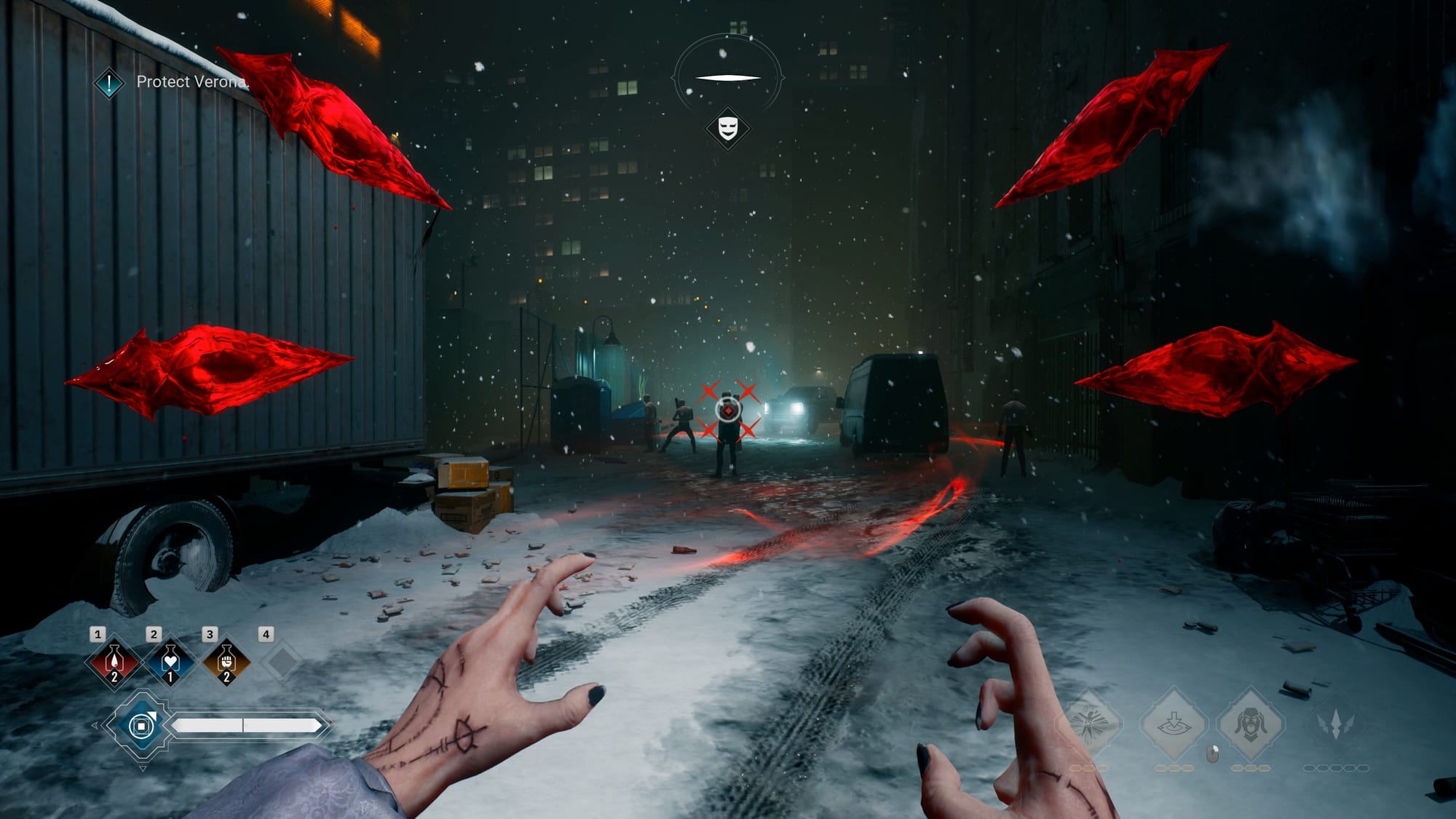
When you do feed on a target during combat, you’ll be presented with a third person perspective attack on your enemy. You’ll sink your teeth into them, leaving yourself vulnerable to attack while you do so. For larger foes, you’ll feed on them, get in their face with a leering growl, then decapitate them with a knife hand. These drag on for a very long time, all the while your foes beat on your back, depleting your health. You have absolutely no way to break away from that animation. If you accidentally feed, you’ll likely end up suffering a true death as a result. Being able to break away from an embrace, dodge, and escape would be greatly appreciated, but at launch it’s a lock and often a True Death sentence. Outside of the feed sequence lock, combat is fast and frenetic, more so depending on your clan choice. Tapping the right bumper issues a basic attack, holding it for a second charges a stronger attack, and combining slides and leaps in any direction modify the attack from a claw to a kick across the jaw, for example. For a mostly two button affair, it works well. Getting the hang of combining your powers with basic attacks takes a bit of skill and time, but after you get a few powers under your belt, the game settles into its combat quirks nicely. You can feel a power progression from a freshly-awakened to someone worthy of the title The Nomad.
As your powers expand and grow you’ll be able to assign up to four of them to your selection cross. Holding the left trigger slows time, letting you pick your power and unleashing it. Each power has a small set of pips underneath – a cost to use it. When you use said power, that pip pool is exhausted in its entirety – there are no half-measures. You’ll need to feed on that many creatures to refill those pips to use the attack or power again. It’s a good method to keep you from absolutely wrecking even the most stalwart kindred in your wake. You also have a few potion types to bolster your armor, refill your health, or top off those pips to keep you in the fight.
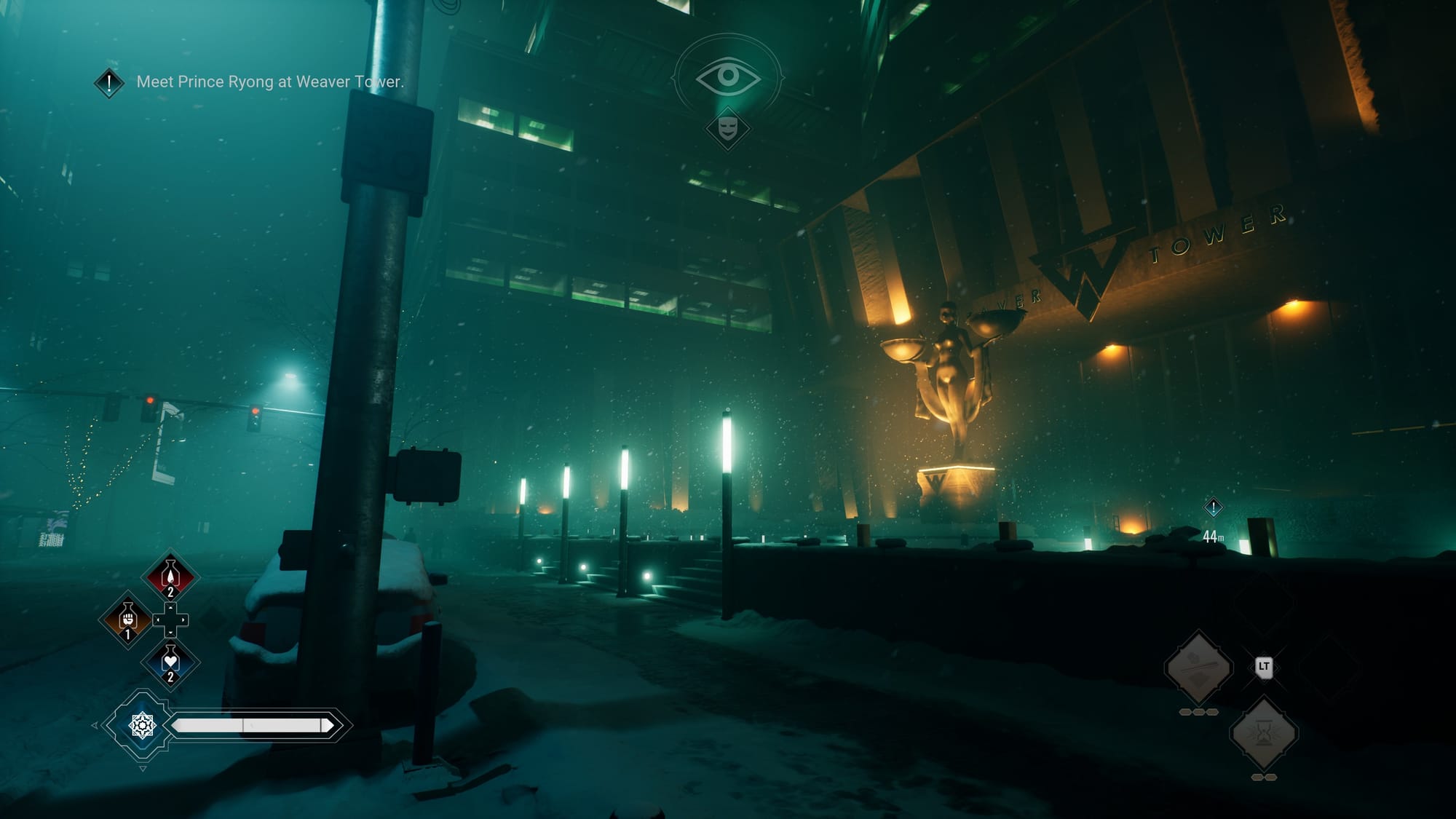
If you end up not clicking with the combat, you can always adjust the difficulty at any time without penalty. Casual makes enemies effectively paper dolls, falling to a single strike or two while dealing almost no damage to you. If you want to just enjoy the story, this mode is here for you. Easy mode bumps the challenge up a notch, but not by much. Normal is how the game was balanced, with the expectation being that players would need to upgrade skills and powers to survive. Hard mode lives up to its name, with enemies able to destroy you with firearms rather quickly. It’s all centered around combat, leaving all other aspects untouched. The storyline is the best aspect of the game, and this game is single player, so find the difficulty level that helps you uncover it.
As a newly-awakened Kindred you are weak with very little health. Direct hand-to-hand combat is ill-advised, even against thinbloods. Throughout the environment you’ll find hidden glyphs painted on the sides of buildings and rooftops that match the symbol that’s been marked on your hand. Using your telekinesis to rip the graffiti off the wall reabsorbs it, helping to reduce whatever suppressive power they have over your health. Pick up enough of these and you’ll have expanded your health by a bit. Similarly, draining kine and picking up other collectables will give you enough XP to level up. The upgrade tree in the sequel is fairly linear by comparison. The way it’s designed makes it almost irrelevant which clan you’ve selected, with it simply being more expensive to buy other powers rather than having them be off limits entirely.
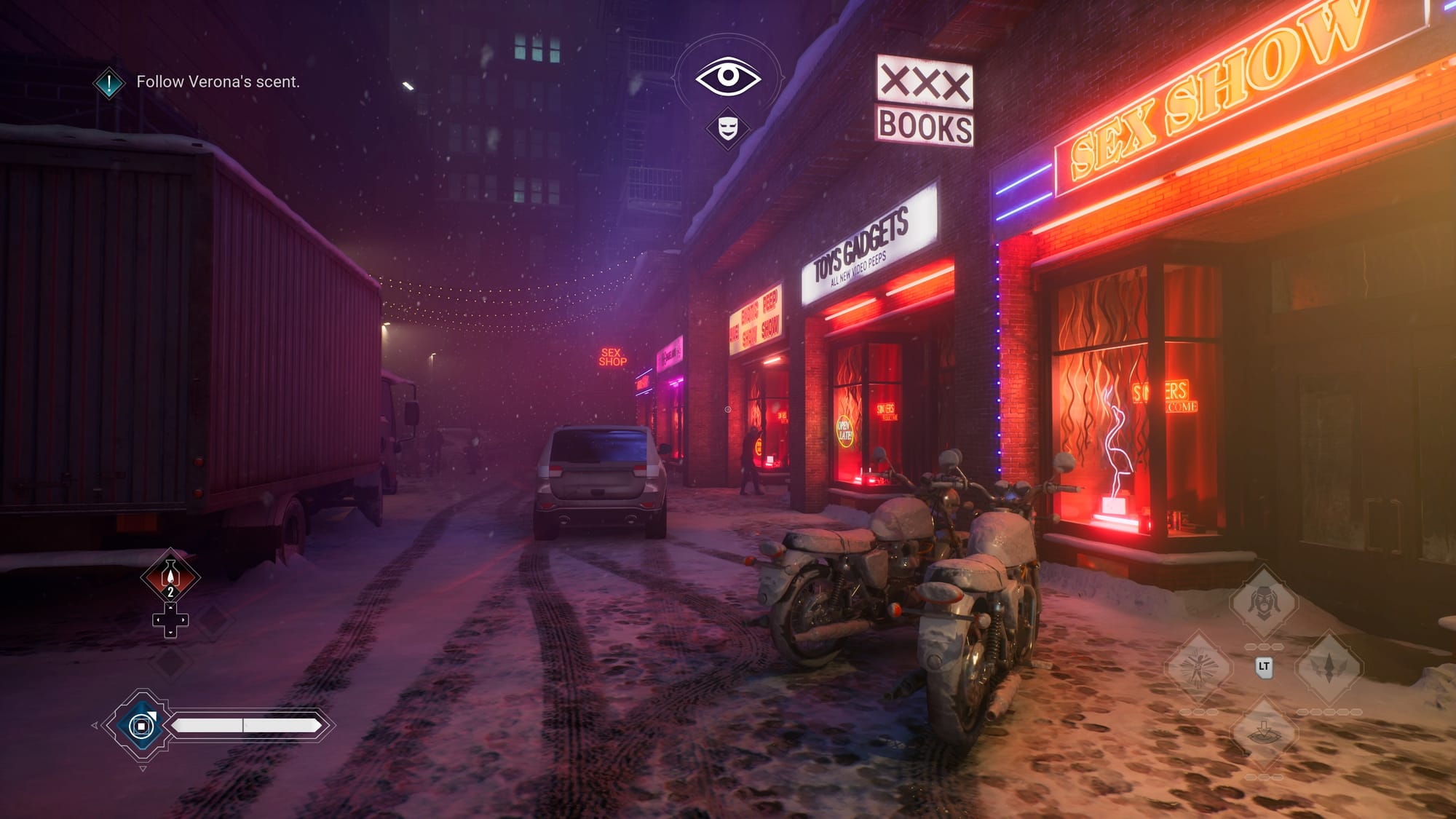
Beyond combat, the most integral part of Bloodlines 2 is the writing, and by extension, conversations. I’ll be honest, I was worried after the first hour as every conversation seemed to boil down to “run through all of the conversation options” to move the story forward, with none of it providing much in the way of choice. Thankfully, once you get off the rails, things change for the better. When you start meeting various movers and shakers in the city your conversations start to have weight and longer term consequences. Ryong Choi, the Prince of the city, is a narcissist, true, but she’s not much for flattery – she prefers deference and formal obeisance. On the other hand, Graham prefers flattery almost above all else. Well, I say all these things, but they might play out differently for you – each one of these characters have their own prejudices against certain clans, and their conversations may play out entirely differently for your playthrough. As you have these conventions you’ll get a Telltale Games- style “Lou was amused by that” or “This angered Ryong” feedback in the corner. Figuring out what buttons to push with each of these Primogens (the Clan representatives of the city) can grease the skids to getting things done in Seattle, or permanently close certain doors based on your relationships. Similarly, figuring out what makes a particular person happy, if they have some clan affinity option, or a romantic interest just might open up additional dialogue options that simply aren’t present otherwise.
It wasn’t long before I was starting to further refine The Nomad’s story (Phyre isn’t the protagonist's name, and many people call them The Nomad, so you’ll hear either), mostly through conversation choices. During one sequence I said “Perhaps you would want to learn more about The Nomad – something you can’t have found in dull history books?” leading to options where I could declare “I was the Sultan’s Astrologer” or “I was a noble prodigy” or “I was a charlatan”. If these sound somewhat familiar, then you’ve played the tabletop version. I had also made a recent decision that was an analog as you get – turning over a captured enemy to one faction over another. While the story and choices start out decidedly linear, it doesn’t take long before you are making more meaningful choices, with a twist depending on previous clan affiliations and relationships.
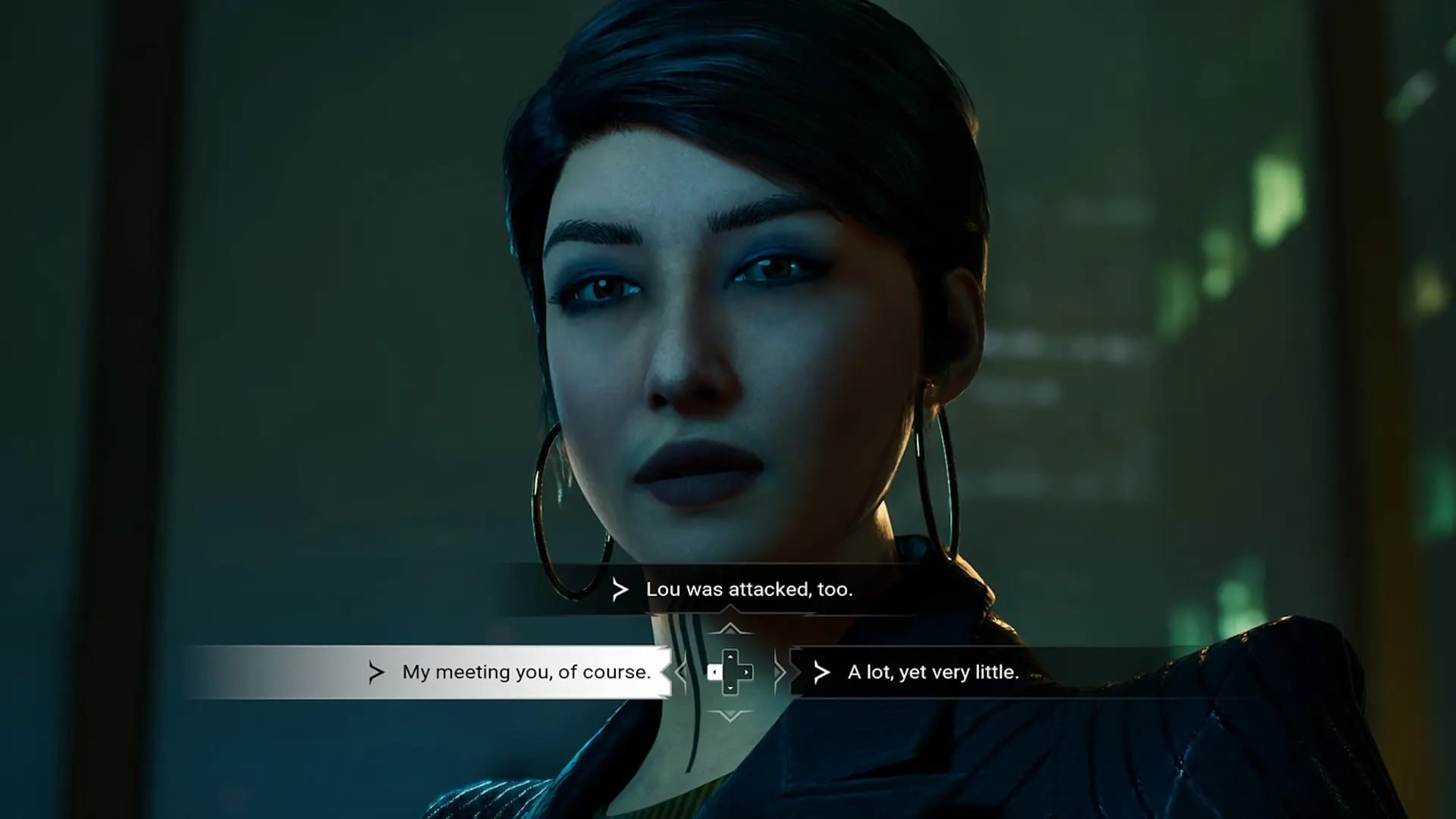
Ultimately, Phyre’s choices are only half of the story as Bloodlines 2 tells two stories inextricably linked. Fabien’s time as a cop started in the 1920s and carries on to today, so he’s seen a great deal of change. He’s also American so he’s familiar with Seattle and American culture more than Phyre would be. As such, his interactions are told either in the past as he remembers things happening to Phyre similar to what had happened to him in the past, or as a voice guiding them. Part secondary protagonist, part exposition, you’d expect this sidecar to be annoying, but it cuts through the surprisingly quiet Seattle streets. In the first Bloodlines game there are several moments that really stick out (other than the dancing), such as the Ocean House Hotel’s “The Ghost Haunts at Midnight” mission. Here it’s just dealing with Fabien’s Malkavian nature. As he has long conversations with papers and filing cabinets, voicing the responses himself, it makes you wonder if any of this is really happening, or if it’s all just in his head, and honestly either way is perfectly fine. It’s a real highlight and worth a few laughs, leading to some very big story moments I won’t spoil for you. That brings me to one area where I think The Chinese Room had to make a lot of cuts – the streets.
Vampire: The Masquerade - Bloodlines 2 takes place in Seattle, or more accurately a very tiny section of Seattle – just about a dozen blocks of it, really. The cars you see parked stay that way, there is no movement in the street beyond the pedestrians, cops, and anarchs you see roaming around. These folks are bloodbags with feet, repeating the same voice lines repeatedly. After two dozen hours I still have no idea what I’m supposed to say in a particular scenario to get them to follow me, so I just generally try to piss them off so they chase me to the nearest alley. Bloodbags aside, the streets are absolutely magnificent. Each storefront is lovingly crafted and decorated with the sorts of things you’d expect in a real-world storefront. It’s the holidays, so there are Christmas presents, wreaths, holiday decorations, mannequins, and advertisements. Move to the seedier parts of town and it gives way to dark alleys and graffiti. The Chinatown-ish part of Seattle is awash in gorgeous neon glows of all sorts of colors. Frankly, it’s some of the best ambiance I've seen in a game anywhere. From the smokey halls of the Makom to the plush-but-dated old-world look of the Glacier Hotel, you can plainly see the painstaking amount of detail that The Chinese Room has crafted into every square inch of this game. So what’s the problem?
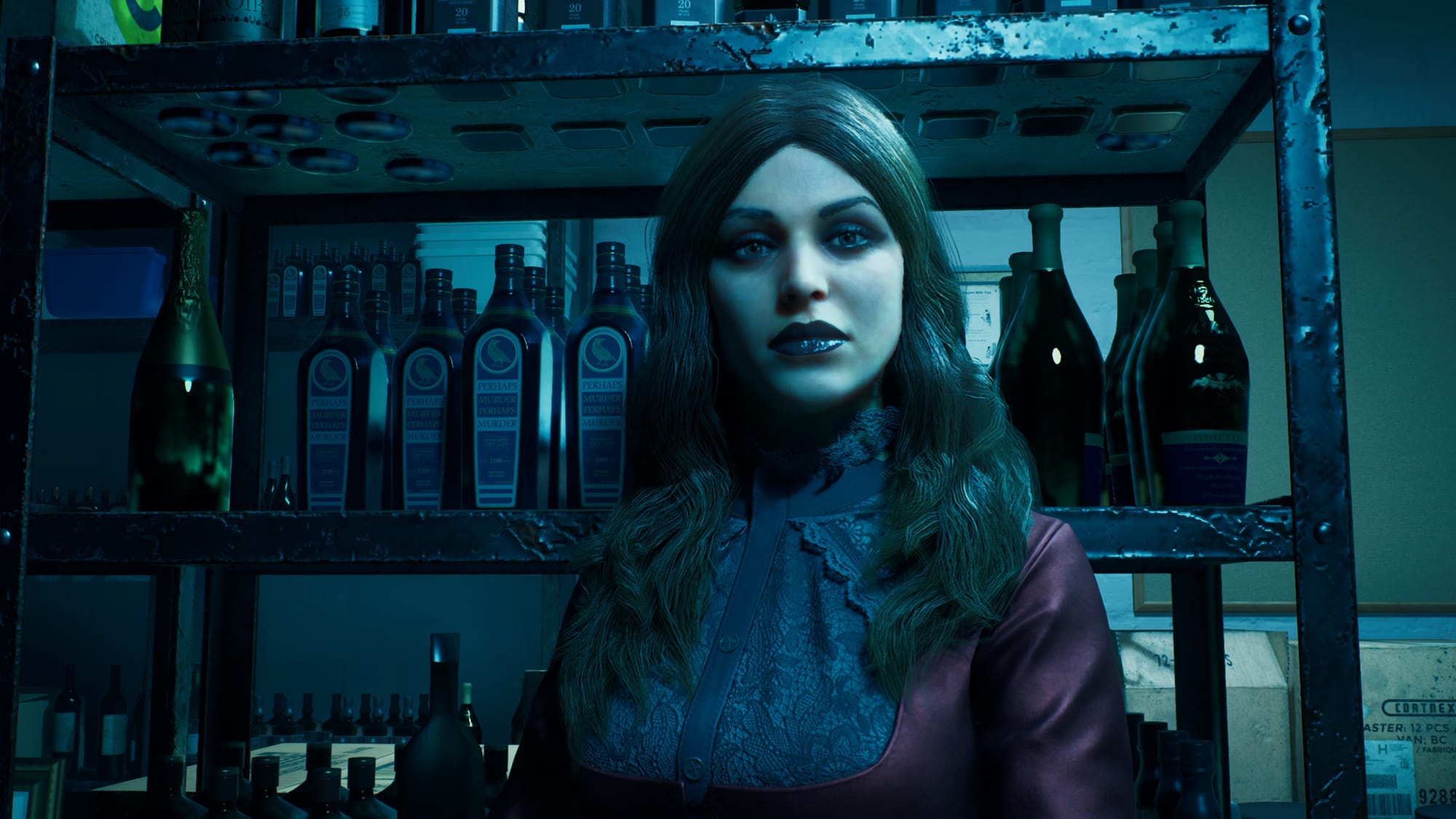
As you awaken you’ll have access to very little. You are a guest, so you can’t visit any of the haunts or hideouts, much less avail yourself of their services. Getting permission to stay unlocks both of those things, as well as conversations with a half-dozen new faces. After you sleep and awaken to a new night you’ll meet a few more. The game slowly feeds you its various denizens and their depravities, but those streets stay the same. There’s little to do, the stores are simply window dressing, and only as the story unfolds will you gain access to new areas. It’s less open world and more akin to what was done with the first game. There is a linearity to it all, despite what the outward appearance of the mean streets of Seattle’s open-ended approach to mission order might suggest.
While your food roams the street, you are an unstoppable predator capable of flitting across the rooftops. Scrambling up the side of buildings via pipes, vents, and air conditioning units allows you to reach the tops of Seattle’s rooftops. Here you’ll almost always be alone. Flinging off the edge, you can glide through the air, carrying yourself through the skyline with a speed you can’t match on the ground lest you break the Masquerade. Every once in a while you’ll run into pesky Anarchs on the rooftops, but for the most part this is your demesne.
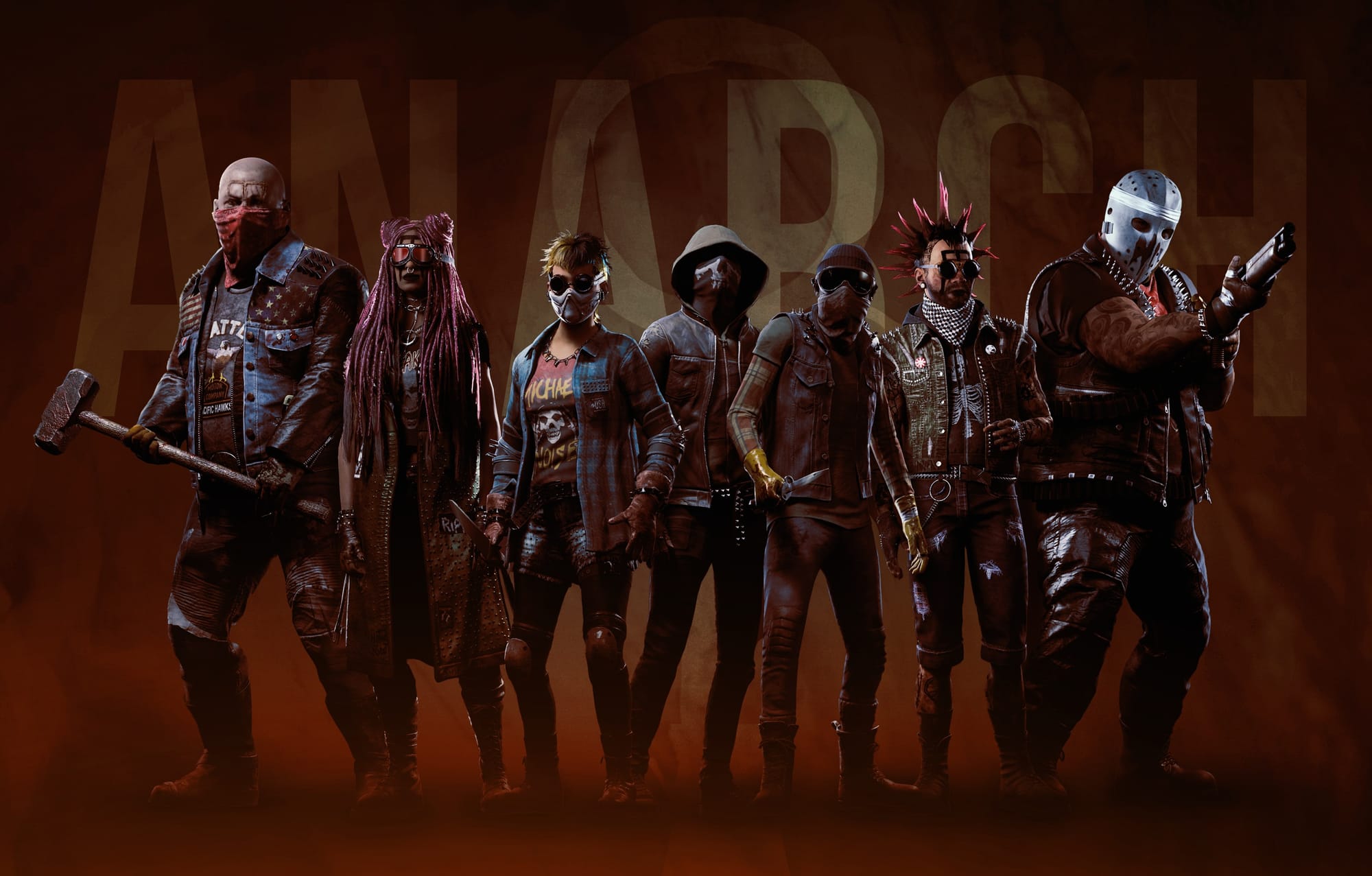
When you sneak up on enemies you’ll have the chance to engage them with stealth. Sneaking up to foes, you can drain them or attack them without alerting their buddies. The AI follows set patrol patterns, allowing you to do a death-from-above attack to dispatch them quietly. There are also kindred powers to assist you to maintain stealth for as long as possible. Surprisingly these also work on bosses, if you can manage to sneak up on them, turn invisible, or get them to lose light of sight on you. Frankly, the AI isn’t all that sharp, so it doesn’t take much to lure them into position or lose interest even though there’s a dead body without a head hanging about.
There is one aspect that I’m compelled to report. While Vampire: The Masquerade - Bloodlines was almost more bugs than game, this sequel is shockingly clean. Every once in a while I’d run into a pedestrian who was talking but without audio, but otherwise I didn’t run into a single bug or problem. Not one. When was the last time you could say that about a big release? If you were concerned about how delays might affect the overall bug count, worry no longer. I’m sure somebody out there will run into some issues somewhere, but I can’t say I did – truly well done Chinese Room team. I am not surprised to see that it runs at nearly 400 fps at 4K on my RTX 5090, but I am surprised at just how much of an impact DLSS 4 has. On my 5090 laptop I am getting between 45 and 60fps at 2K resolution / max settings, however when I enable DLSS 4 I’m seeing around 210fps. Same with the 5090 FE, but we go from 100 to over 400 at 4K / Max. Popping all the way back to a 2080 Max-Q I was still seeing triple digits. It’s incredibly well optimized, and with the day 1 drivers, there doesn’t seem to be any hitching that you usually find plaguing Unreal Engine 5 games.
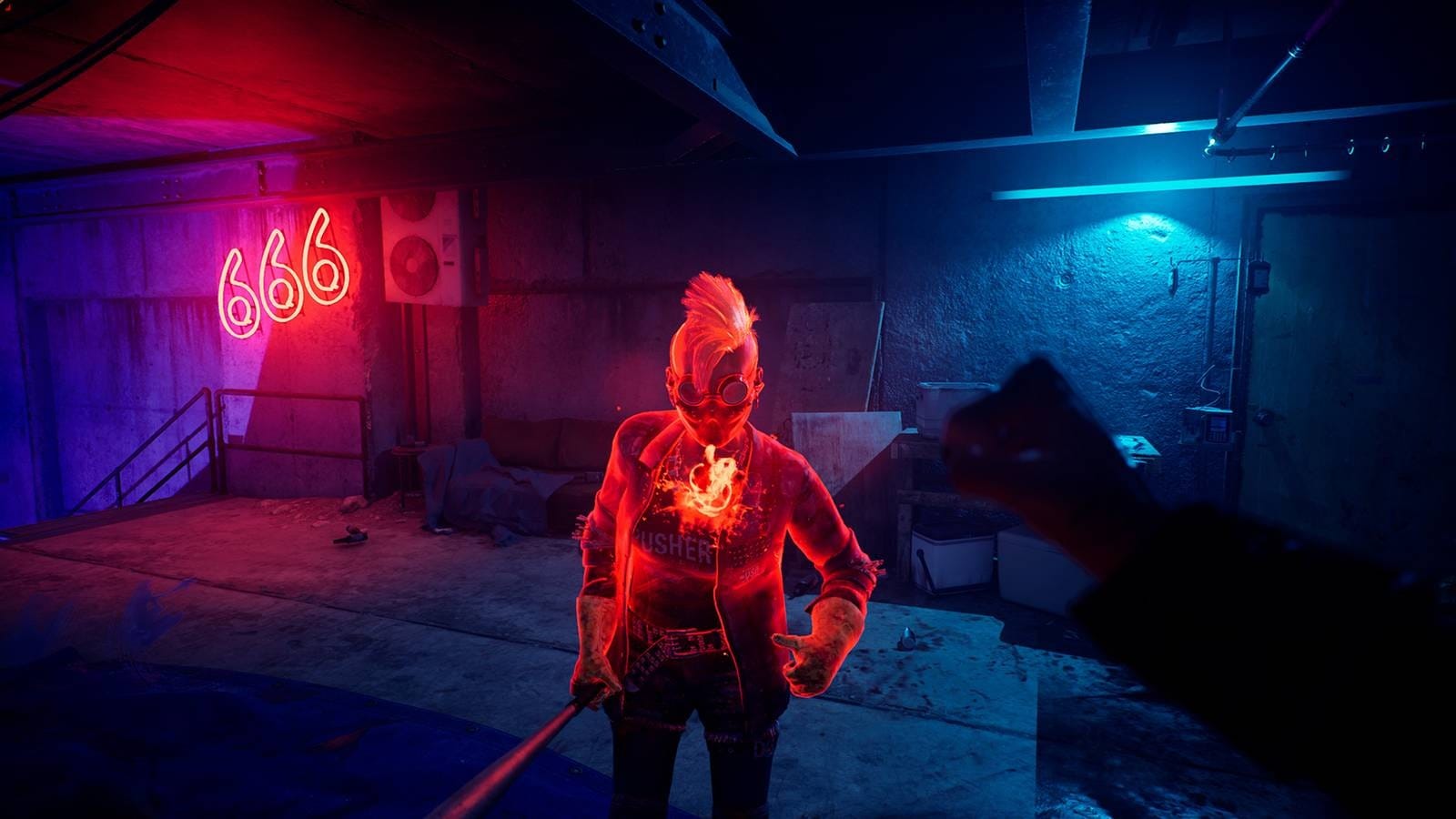
From the dark and seedier parts of town to the gorgeously-rendered clothing, faces, hair, and mouth synchronization, this game is a looker from top to bottom. Chinese Room didn’t stop there, though – they matched it with a phenomenal cast. Below you’ll find a video that reveals the cast behind the fangs, and you’ll be unsurprised to see a few famous names. They all put in incredible performances, with standouts being almost the entire list of names. I personally found Lou to be one of my favorites, along with Amrita Acharia’s portrayal of Safia with her fawning obsession with the protagonist. Honestly, I could just throw the link to IMDB here as there only voice acting that isn’t great is that of the meatbags in the streets, not because they deliver their lines poorly, but because they’re repetitive.
Outside of voicework, the audio feast continues with the help of original composer Rik Schaffer, joined by Craig Stuart Garfinkle and the internationally renowned Eímear Noone to bring the soundtrack of Seattle to life. While I miss hearing Lacuna Coil (their poster is in your apartment in the original, as are some of their tracks off of Comalies), this trio have delivered a very-listenable soundtrack. If you pre-ordered the game you’ll find a jukebox of these tracks in your haven.
It’s easy to look at the move towards action and less RPG elements and feel like it’s a step backwards for the series – something I suspect will have a great deal of debate among fans in the days to come. What shouldn’t be a matter for debate is the strength of the writing. The Chinese Room understands the world of Vampire. Every interaction is a showcase of excellent motion capture, facial work, graphics, and writing that runs circles around all but the shining stars of the genre. In-world jargon like Sabbat, childe, diablerie, caitiff, kine, and coterie are just a sampling, but they are all well-sewn into the dialogue without forcing an exposition dump for more casual players who might not have played the first game or the tabletop version.
The Chinese Room had an impossible task with Bloodlines 2, and no matter how well they did, some fans were going to be unhappy with their changes. Looking at their previous work informs you about the kinds of games they enjoy making, and as such they’re going to put their own fingerprints on this world. The world can feel a bit empty at times, and combat can slide into repetitive, but the world building, aesthetics, and writing are top shelf. This could have launched, frankly, in the poor state that the original did, but somehow it did not. The true test of any good game is that it contains moments that stick with you long after the credits roll. It can wash away the frustration with combat, and the various clan choices and powers make it the kind of game you’ll want to revisit time and again to uncover those hidden elements that you might have missed simply because of your clan alignment. The wait for this game was, generously, overly long. I’m just happy to find that it ended up somehow being worth it - even if it isn’t the RPG stat fiddling sequel some hoped it could be. Come for the story and absolutely phenomenal visuals, but stay for the Masquerade.
Vampire: The Masquerade - Bloodlines 2
Good
Vampire: The Masquerade - Bloodlines 2 is an ambitious, gorgeous, well-written, and enthralling story set in a world that’s all-too-quiet at times. The story told stands tall, just know that it’s wrapped in combat and mechanics that can, at times, feel a little thin.
Pros
- Gorgeous and well-optimized on PC
- Excellent writing
- Compelling characters and excellent voice work
- Clans can extend story into additional playthroughs
- Highly atmospheric
- Malkavians continue to be crazy fun
Cons
- Combat can be repetitive
- Seattle is small and sparsely populated
- Occasionally obtuse or confusing mechanics
- RPG elements have been stripped back
This review is based on an early PC copy provided by the publisher. Vampire: The Masquerade - Bloodlines 2 comes out on October 21, 2025.
